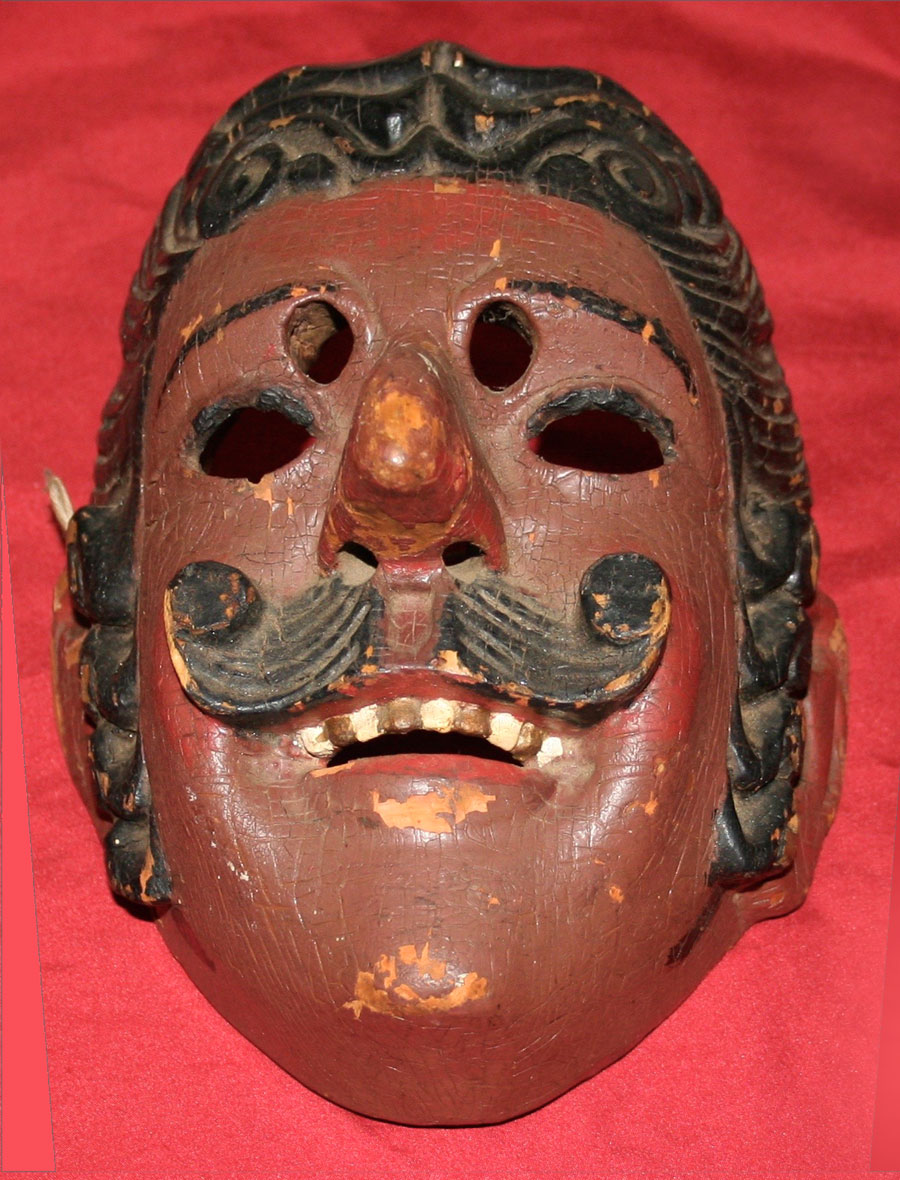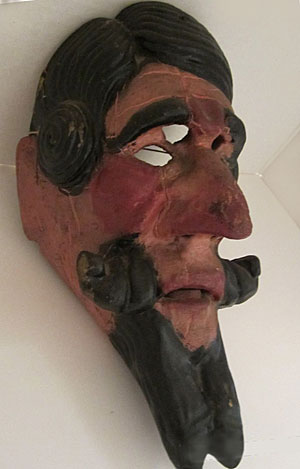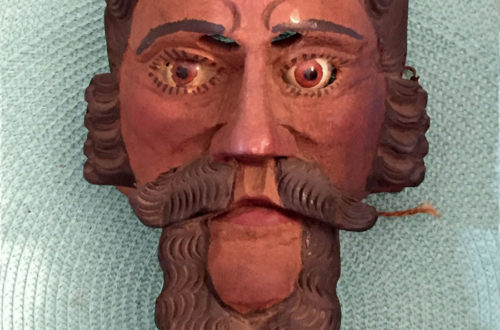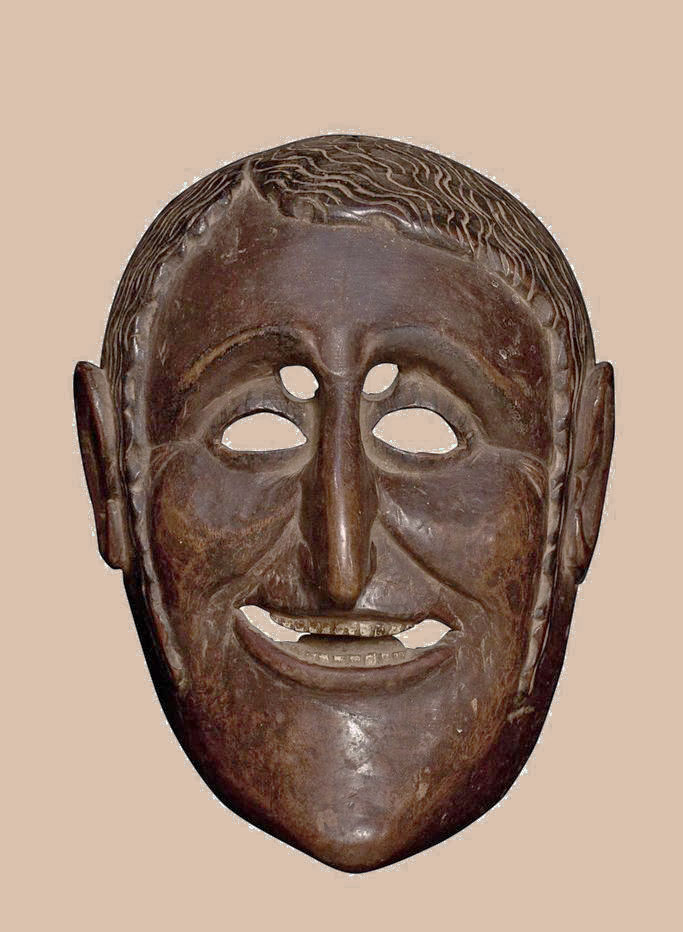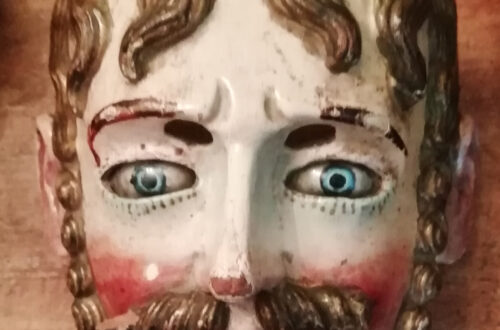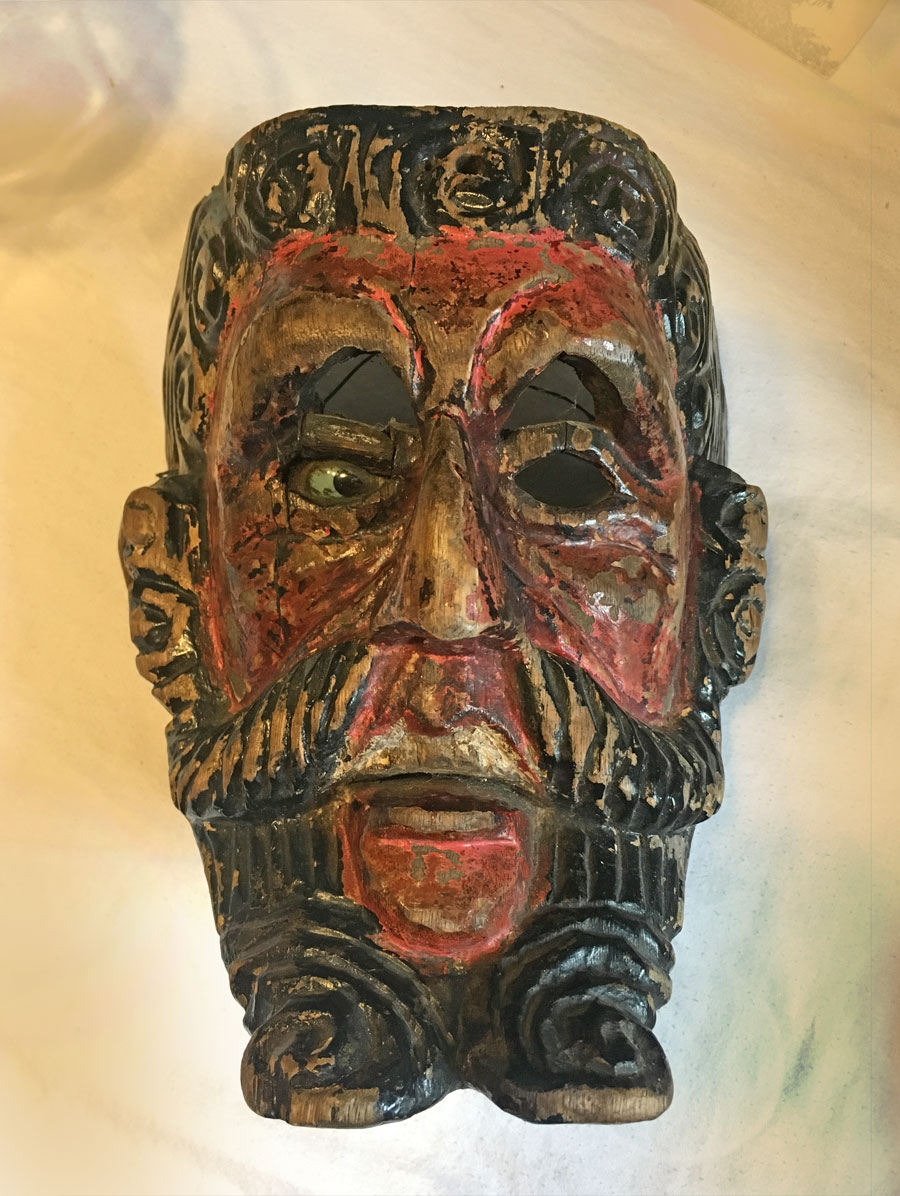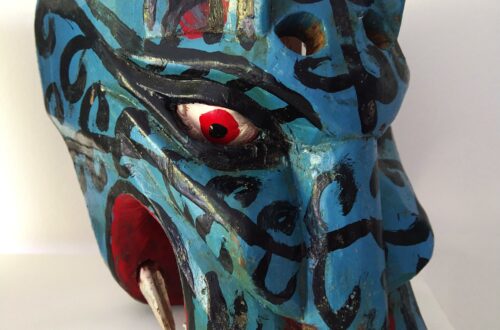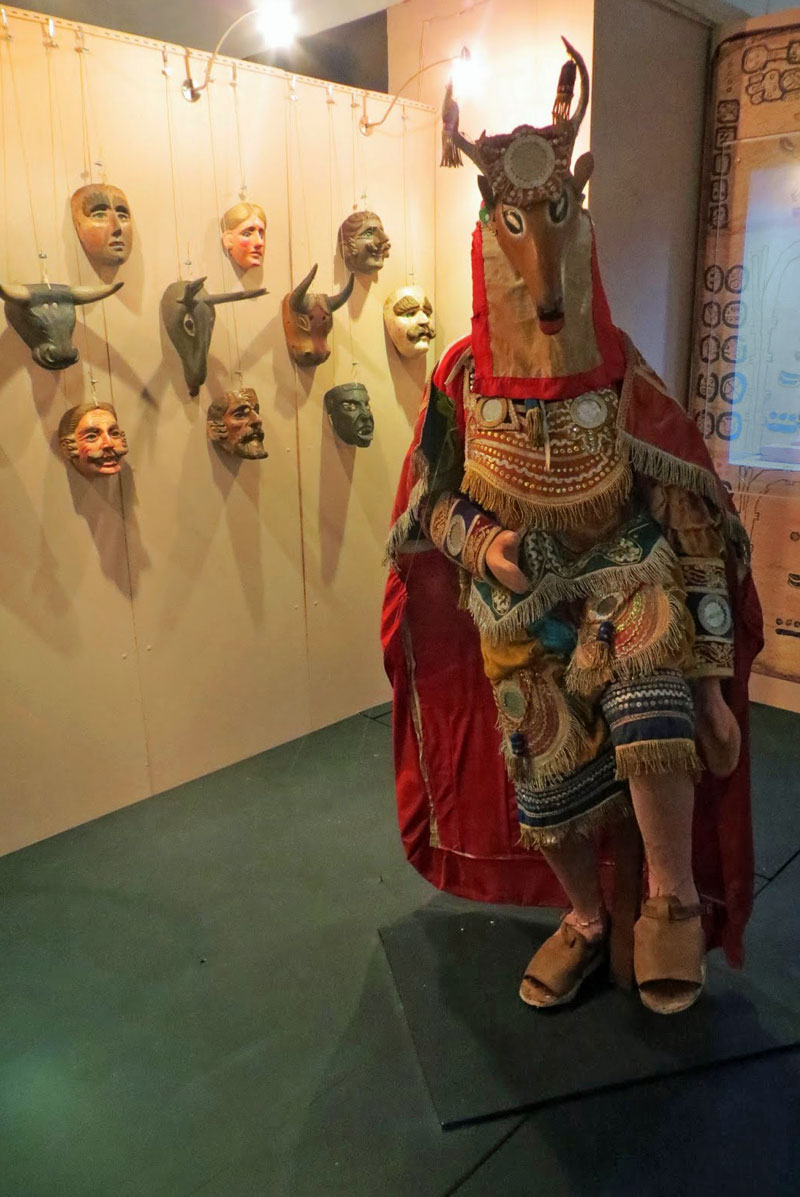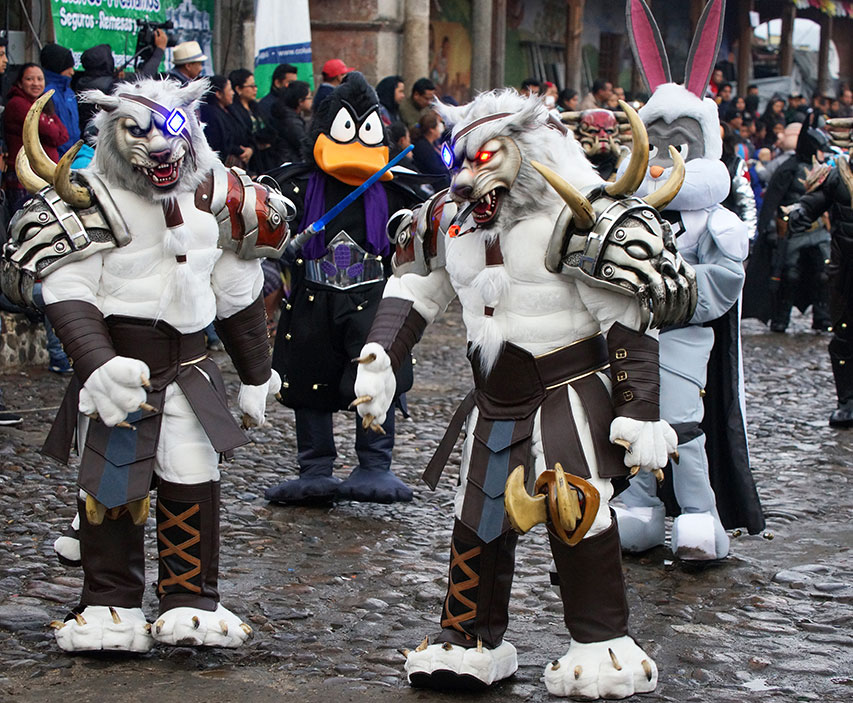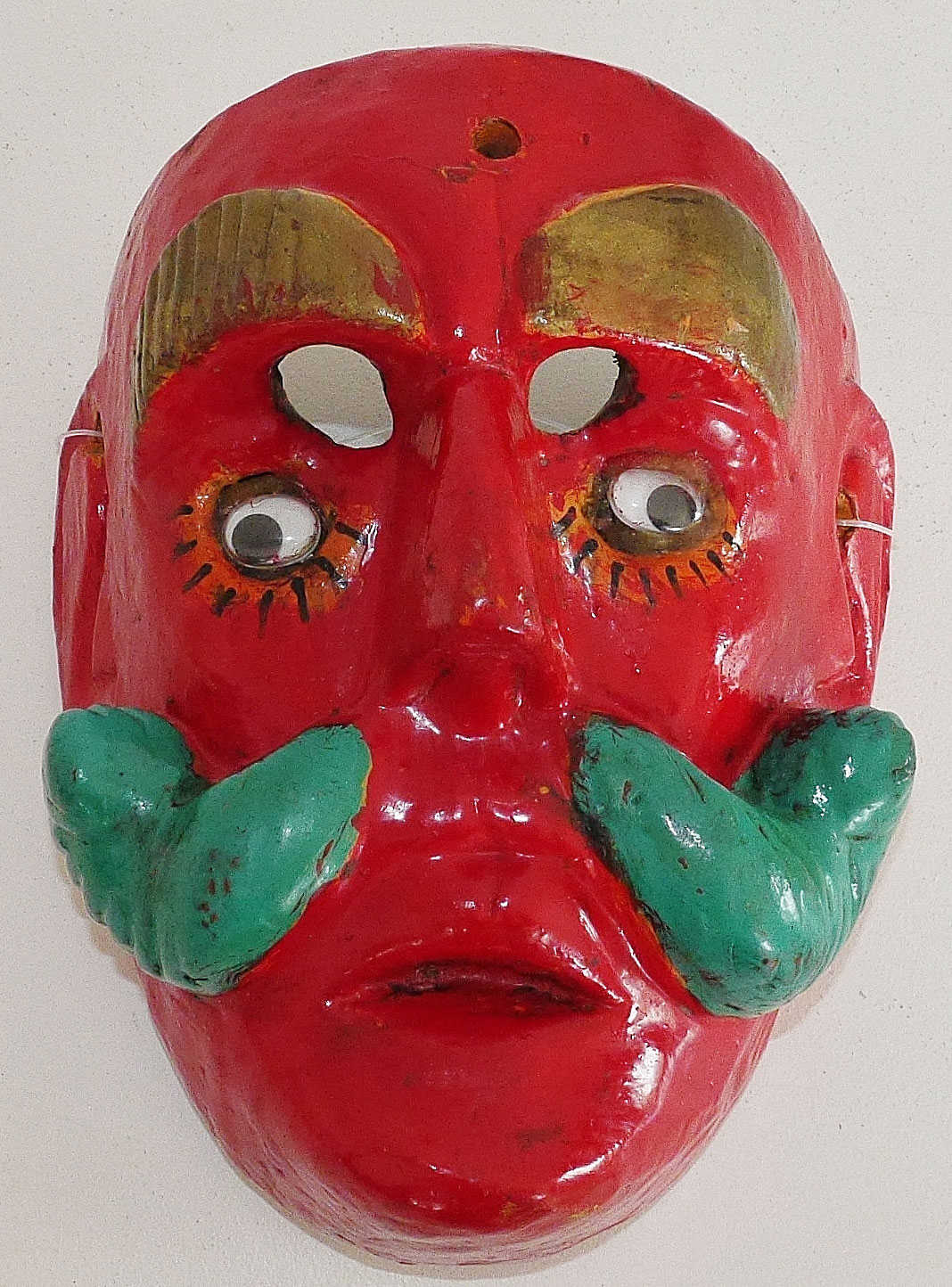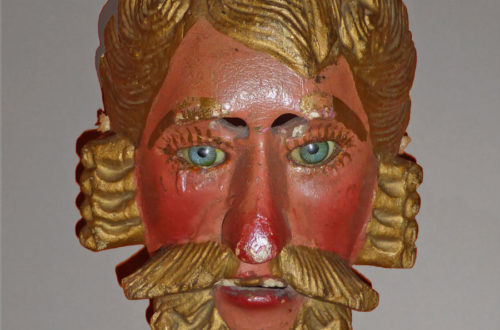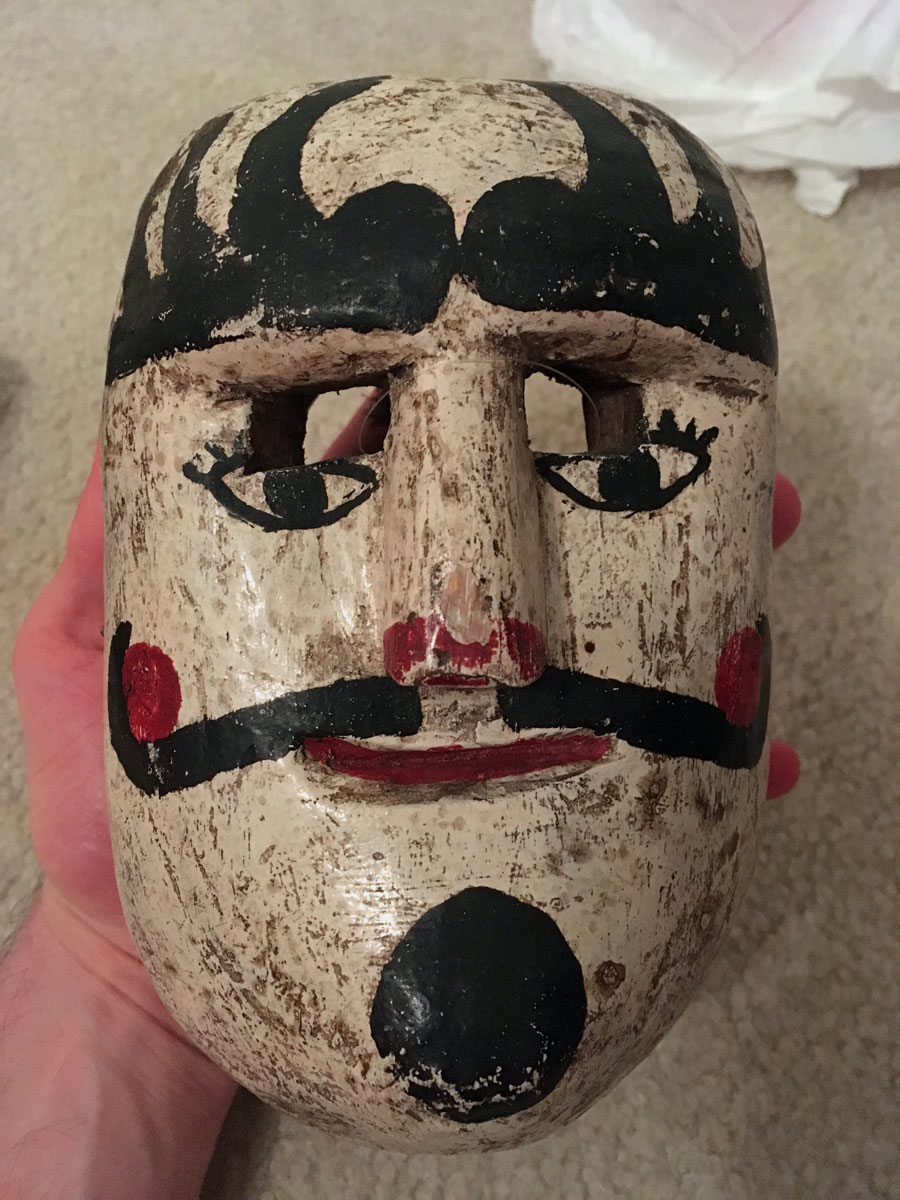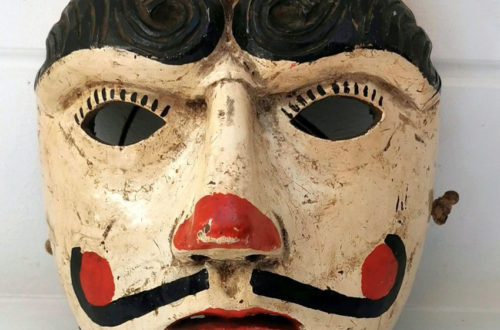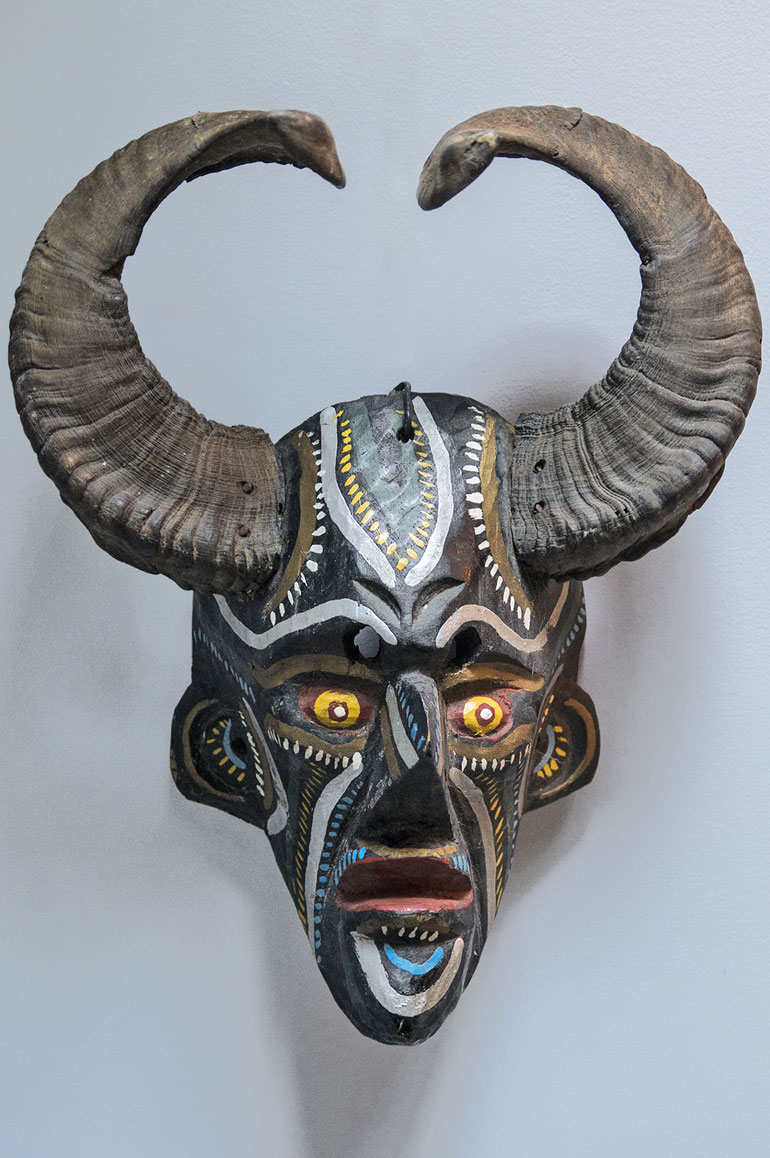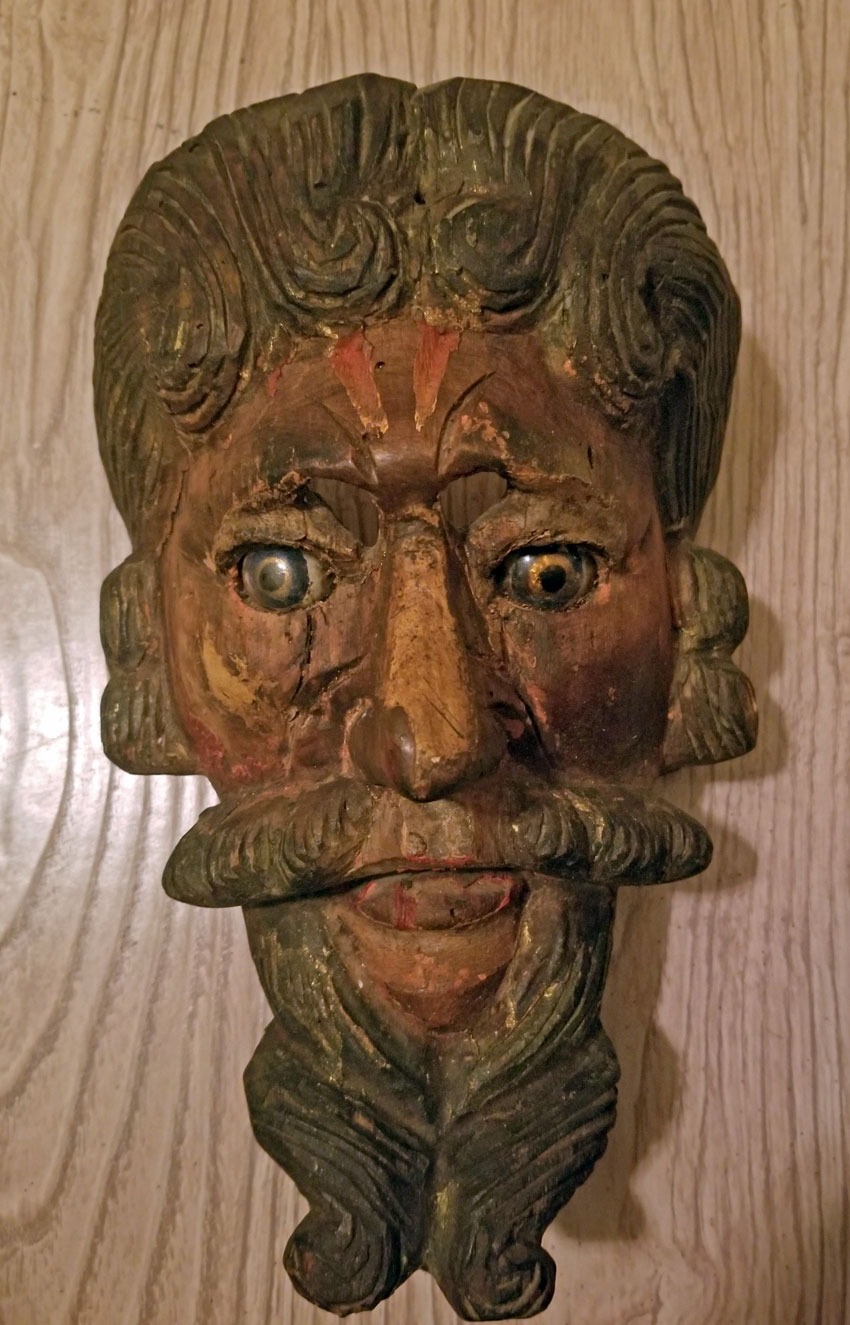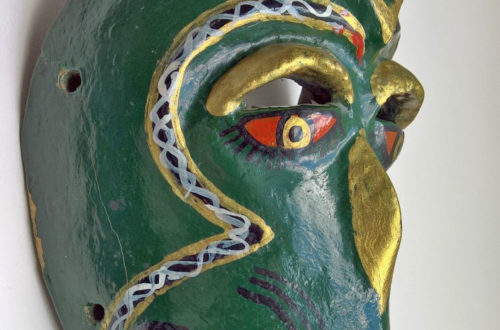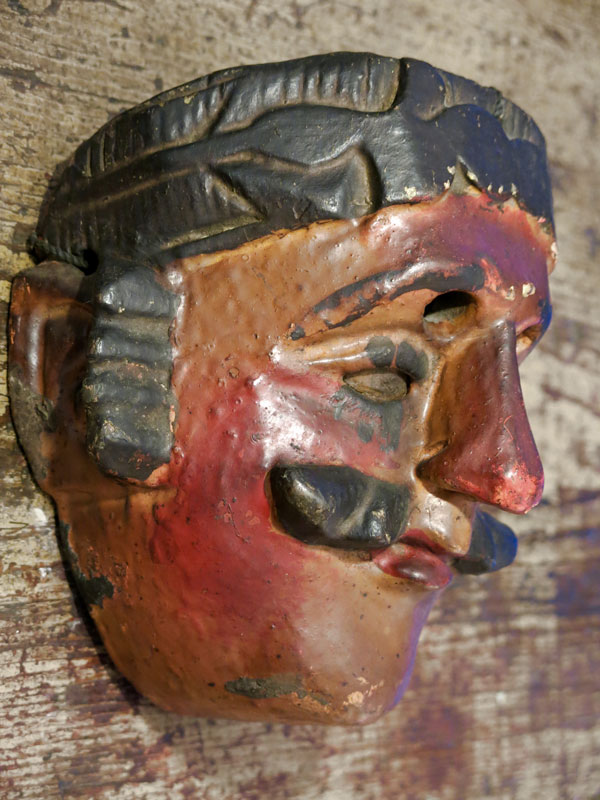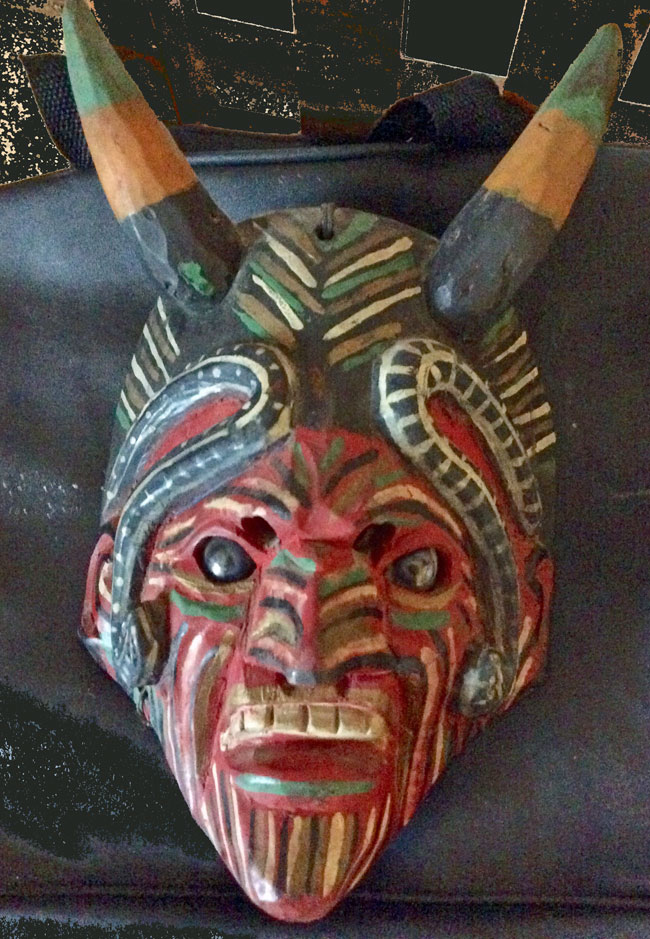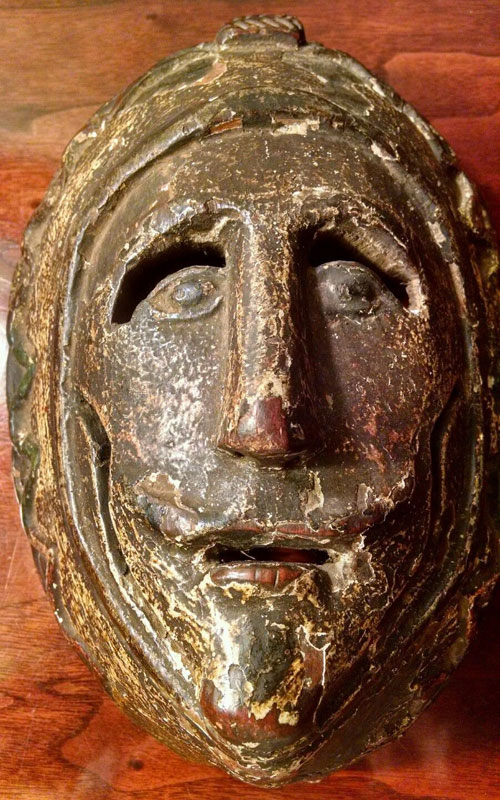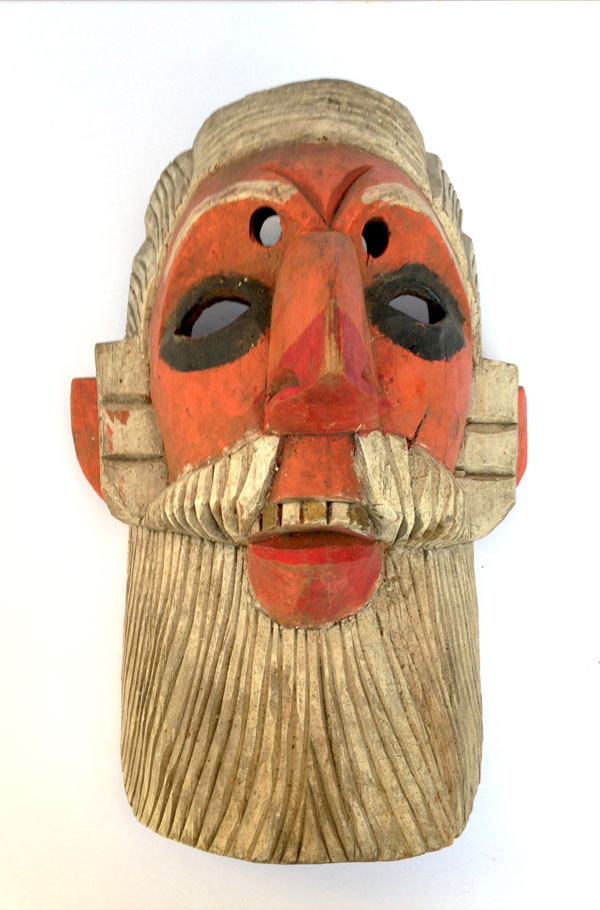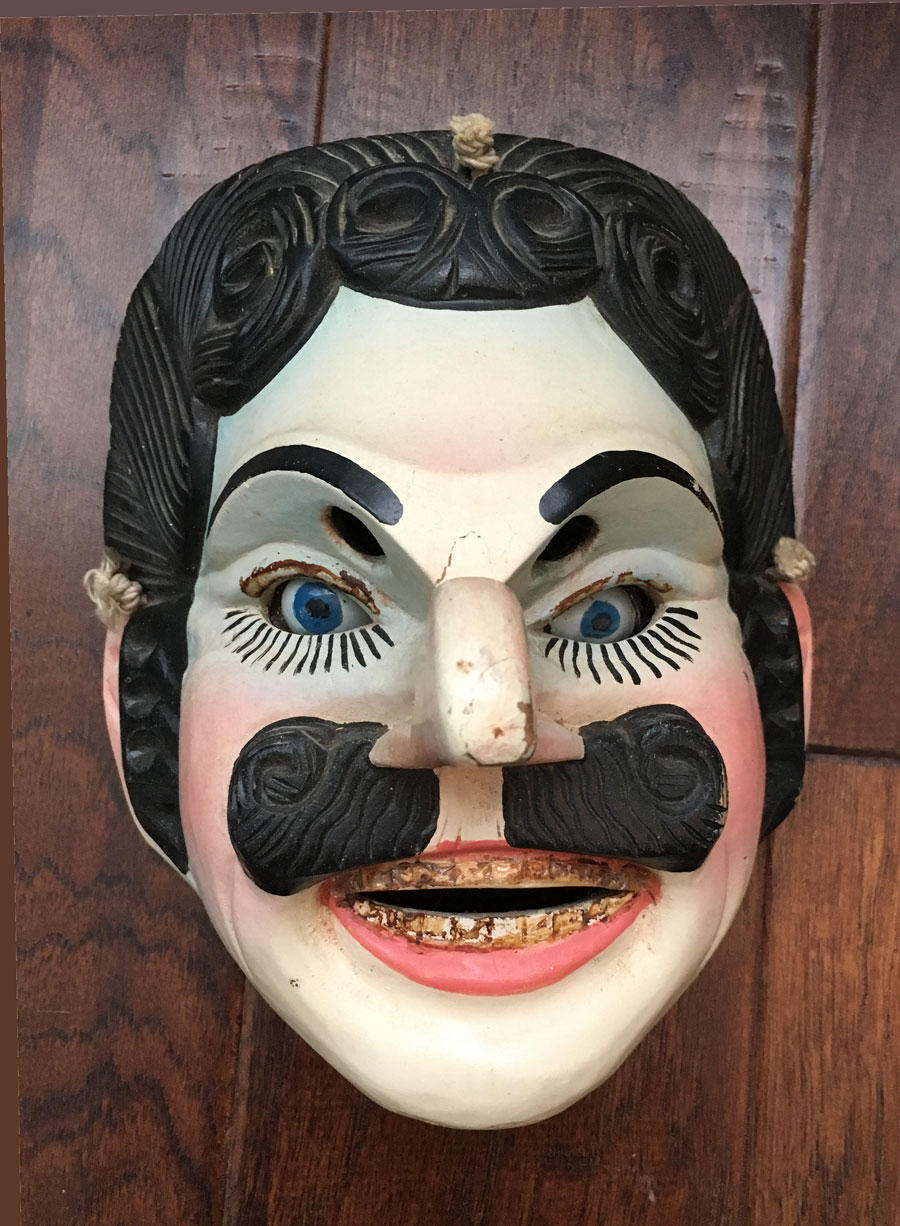Q: I recently picked up this mask. I think it is Guatemalan. It appears to be Pedro Alvarado. I am wondering if this may be the case. Any information would be helpful regarding this mask.Thank you, Don, 1352 A: You are close, but it is The Mexican, not Alvarado. You can learn about either character by going to Google. Here’s the good news. Your mask might be authentic. Most of the masks sent to me are usually reproductions or cheap tourist junk. For the latter I try to write a nice reply, but I don’t post it. A
-
-
Old Guatemalan mask
Here is an old conquistador dance mask that hasn’t been used a lot. Expressively carved from hardwood, the eyebrows, eyelashes, hair and upper lip show remnants of black paint, while the teeth have traces of white. His wavy side-parted hair and long sideburns were characteristic of the Spaniards depicted in these dances. His glass eyes are now missing. There is no morreria mark that I can see. I still like it!
-
Another Pedro Alvarado
Q: I am cleaning out my father’s home/estate and he had several masks (mostly Mexican). I believe a few are antique and at least one may be pretty valuable. I have attached pictures below and can follow-up with more pictures if you would like to see them. I am mostly curious about this one that I think is over 100 years old. Laura, 1325 A: What a coincidence. The same character comes in a day later. Laura’s Alvarado is a tourist mask that has been artificially aged, where as, yesterday’s is authentic.The biggest difference would be the quick carving and black paint on the rear of today’s. Neither of these…
-
Popular mask of Pedro Alvarado
This is a favorite character in one of the most important dances performed in the hills of Guatemala. Heavily influenced by Western classical sculpture, the carvers, who are ethnic Mayans, make sculptures as if they were trained in the finest art schools of Europe. Unfortunately the quality of Guatemalan carving has gone down in recent years. If you go to the Guatemalan section of “Categories” you can see other examples of this kind of carving, both recent and older. I would give this mask an A- .Read more about Avarado, the famous Spanish general.
-
Repro of Patron mask from Guatemala
Q: I recently bought this mask and I would like to know if it’s authentic or if you would know anything more about it. The seller said it was a dance mask from Chichicastenango, Guatemala from the 1950s-1960s. The mask measures roughly 7” in length and 5” in width. Any help would be appreciated. Daniel, 1265 A: Here’s what Aaron has to say about a similar mask that is authentic. This is one is not, but it certainly looks like the real thing. B SUBREGION: Nahualá ETHNICITY: Mayan DESCRIPTION: Patrón Mask MAKER: Unknown CEREMONY: Danza del Patzcar AGE: 1980s MAIN MATERIAL: wood OTHER MATERIALS: oil-based paint; leather The Danza…
-
Another New World Devil Mask
Q: I’ve had this mask in my collection for quite some time now. I found it at a local antique shop for $60.The mask itself measures about 9.5 inches excluding the length of the horns. The horns have been nailed on the mask, and look like real goat horns.I have always believed it to be some kind of hand carved Diablo mask judging by the inside of it. What do you think? Blake, 1170 A: Your mask is a Diablo (Devil) from the state of Totonicapan in WestCentral Guatemala. On pages 252-5 of Guatemala’s Masks & Drama by Jim Pieper you can see several of them and read the story…
-
Guatemala is the place for masks
This photo was taken at a museum in Guatemala City. The featured mask (with costume) is for the Deer Dance. The ones on the wall come from different dances. Shops will rent masks and costumes to the locals for an affordable price. They’re called morerias. This small country takes masquerade very seriously. There are many unique masks for tourists and collectors to enjoy. In my book, Masks of the World, I devote a whole chapter to this special part of the world. Save
-
Devil mask from Guatemala
Q: I know that this mask is at least 55 years old. My mother bought it sometime around 55 or 60 years ago. I do not know if it was new or used when she purchased it. Was wondering approximate value and where from, although it is not for sale. Pat, 1114 A: Devil masks have been gaining popularity in Guatemalan dances ever since Catholic priests started introducing them hundreds of years ago. Hanging out with with the dreaded coral snake would be a Mayan addition. This mask has glass eyes, snakes and wood horns that can be removed. It was made for sale to tourists. If it was for…
-
Pretty cool Guatemalan mask
Q: I have 2 mystery masks. Here is the first one. Paid $18 for a antique extravaganza. Could it be from Guatemala? Mexico? It’s pretty cool. Gena, 1100 A: I picked this one to post. Indeed it is a cool mask. Even though a cheaply made commercial product, it looks so Guatemalan. You know instantly it could come from nowhere other than the mountains of Central America. Of course, most serious collectors don’t want “tourist junk” on their walls. Perhaps some collectors would be revolted by this guy (especially anthropologists), but I think the mask is a keeper! C Save Save
-
The evolution of masquerade in Guatemala
Most of the world’s folk art continues to evolve. I asked Aaron about the way Guatemalan masks have changed over the last 35 years. Here is what he said. If anything dramatically illustrates the changing traditions, I’d say it was the convites masks. The convite tradition goes back to medieval Europe and represents a relatively popular celebration of a local saint. I say “popular” in contrast to other dances, which typically involve heavily rehearsed dances by persons who spend quite a lot on buying or renting costumes from a morería. The elaborate costumes and masks for the Baile del Torito or Baile de la Conquista, for example, cost about 3…
